IDEX Online Research: Weak Mother’s Day Jewelry Demand Hurts May Sales
July 16, 09
Mothers in America who were expecting jewelry in May for the traditional Mother’s Day remembrance were probably disappointed this year. Jewelry has historically been an important gift for this key selling period for jewelry – it is the third largest sales period of the year, after Christmas and Valentine’s Day.
But this year, jewelry sales were especially weak for specialty jewelers, who as a group experienced an 11 percent decline in sales versus the same month – and versus the same Mother’s Day selling period – a year ago.
Early reports from many specialty jewelers had indicated that May was weaker than April, so we were not surprised that the preliminary government numbers confirmed this trend. On a year-over-year basis, specialty jewelers’ sales fell by a greater percentage in May than in April.
The good news is that the overall rate of sales decline continues to diminish. More importantly, the year-to-date sales decline – January-May 2009 versus January-May 2008 – also continues to narrow. For example, at the end of March, year-to-date jewelry sales for specialty jewelers were down 13.9 percent; by the end of May, specialty jewelers’ year-to-date sales were down by only 12 percent because of improving conditions in April and May.
We believe the worst is behind us. Sales comparisons were at their most disappointing levels in November and December 2008, with less onerous comparisons in January, February and March. April’s jewelry sales numbers, while down year-over-year, declined by only 7 percent (revised downward from a 5 percent preliminary decline). Said in a more positive way, specialty jewelers’ sales in April ran at about 93 percent of last year’s levels, after running at about 85 percent for the prior three months. In May, specialty jewelers’ sales were down by about 11 percent; they were running at about 89 percent of last year’s levels. While this is still disappointing, it is not the end of the world, contrary to some jewelers’ opinions. With proper cost controls, and exceptional marketing, many jewelers are reporting sales gains and steady profits.
The graph below illustrates jewelry sales trends by month for specialty jewelers in the U.S. market.
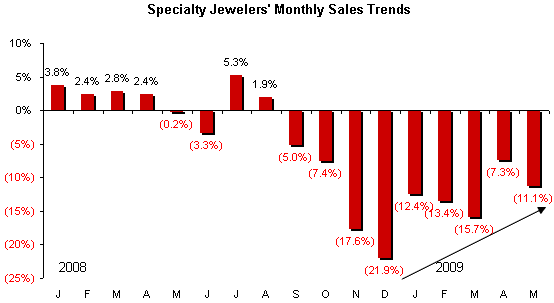
Source: US Dept of Commerce
Revised Improved 2009 Sales Forecast Confirmed
Last month, we raised our jewelry sales forecast for the U.S. market for the full year of 2009. Based on the latest data, we continue to confirm our forecast which shows that jewelry sales could be up very modestly for the year. In 2008, total jewelry sales in America were roughly $65.8 billion. The government’s current annual “run rate” for jewelry sales is $65.9 billion, based on sales for the five-month period ended in May. Given the current conditions, our prior forecast of a jewelry sales decline of 10 percent in 2009 appears to have been too pessimistic. It is too early to start celebrating, but clearly the government’s programs to stimulate the economy appear to be having a positive impact.
We note, however, that we are entering the “summer doldrums,” a period when jewelry sales are traditionally weak. There are no selling events to drive shoppers into jewelry stores until the 2009 November-December Christmas sales events. In the meantime, we think there will continue to be periods of weakness in demand for jewelry, but it appears that the worst is behind us.
The U.S. economy is showing some vitality, after significant weakness over the past year. Three factors are having a positive impact on the U.S. economic recovery:
- The U.S. government has thrown all of its defenses at the recession early in the economic decline, long before other nations. Unfortunately, some nations around the world are still arguing about what to do – they remind us of Nero fiddling while Rome burns.
- The U.S. economy is far more resilient than most people understand (especially the mass media).
- The Federal Reserve is engineering the stimulus to put the U.S. economy back on track. If there is one thing we’ve learned over the years, it is this: don’t bet against the Fed. The Fed may not be perfect, but overall its success record is enviable.
May Specialty Jewelers’ Sales Far Less Weak than Earlier This Year
Specialty jewelers posted sales of just under $2.3 billion in May 2009 versus $2.6 billion in the same month a year ago, a decline of about 11 percent. This helped reduce the year-to-date sales decline for specialty jewelers to about 12.0 percent.
Total U.S. jewelry sales – at all merchants, including specialty jewelers as well as discounters, mass market merchants, and others – posted an annual run-rate of $65.9 billion in May, notably above the average run rate in the first quarter of about $64 billion. These figures compare to 2008’s total jewelry sales of $65.8 billion, and they are showing improvement from prior months’ comparisons.
Again in May, the Department of Commerce made significant revisions to its sales database for the past five years; thus, these numbers may not agree exactly with data published previously by IDEX Online Research. Further, the Bureau of Economic Analysis has also made significant revisions to its “total jewelry” sales database, so prior published comparisons are slightly different from current numbers. We are seeing revisions in government numbers more frequently and at a greater magnitude than at any time in the past couple of decades; apparently, the volatile economic conditions are significantly affecting the integrity of the published preliminary numbers.
The table below summarizes retail sales and consumer spending trends for total jewelry, specialty jewelers, and all retailers for the past three months ended April 2009.
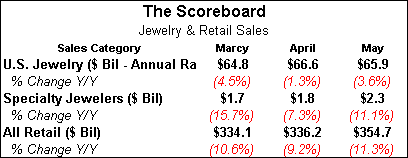
Source: US Dept of Commerce
Specialty Jewelers Lose Market Share in May
Preliminary jewelry sales numbers for the prior month – April – suggested that specialty jewelers were on the verge of perhaps picking up a little market share. Unfortunately, April’s sales figures for specialty jewelers were revised downward, and May’s numbers show an even greater disparity. Thus, specialty jewelers continue to lose market share, a trend that seems to occur during recessionary periods. As the table above illustrates, prior months’ comparisons showed that specialty jewelers lost significant market share in March, April, and May. In 1972, specialty jewelers had 73 percent of the market; by 2008, their market share had slipped to 43 percent. Historically, specialty jewelers tend to lose market share in recessionary periods, and they never regain that lost market share.
The graph below contrasts specialty jewelers’ sales trends (red line) with total jewelry sales trends (blue line) for the past year.
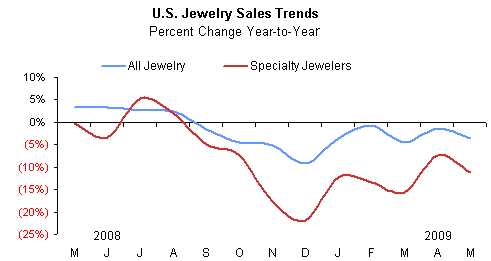
Source: US Dept of Commerce
Jewelry Demand Lags Other Retail Categories in May
In May 2009, specialty jewelers’ sales were down 11.3 percent, while total retail sales, ex-auto and food, were down 10.3 percent. Thus, jewelers lost a little market share to other merchants in May. We eliminate auto and food categories because they can distort overall consumer demand trends. Auto sales are driven by the “deal of the day” promotion, while food demand is not discretionary. If auto and food categories are included, U.S. retail sales were down 11.3 percent in May, roughly in line with the decline in jewelry sales.
The graph below summarizes sales trends for all retail goods (green line) excluding food and automobiles versus specialty jewelers’ sales (red line).
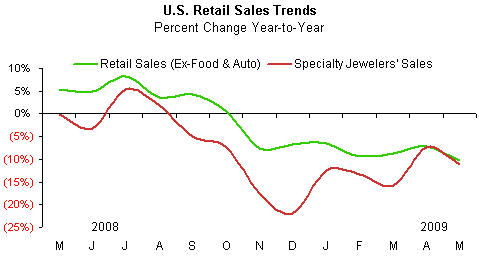
Source: US Dept of Commerce
Consumer Spending Remains Weak in May
Total consumer expenditures declined by nearly 3 percent in May, the weakest month so far this year. The on-going decline in consumer spending is due to two key factors: 1) weaker consumer demand due to recessionary pressures; and, 2) lack of price inflation. In January, consumer spending was 1.3 percent below the prior year. However, in February, consumer spending dipped by only 0.8 percent from the same month in 2008. In March, revised data shows that total consumer spending was down 1.8 percent - said another way, it has been running at roughly 98-99 percent of last year’s levels. Unfortunately, in April, the downdraft in consumer spending continued: down 2.3 percent (revised), followed by May with a sharply lower 2.8 percent decline.
What is behind slowing consumer expenditures? As the graph below shows, total retail sales growth took a dive in the early fall of 2008. Spending on big-ticket durables – often financed on credit – suffered the most. Consumer expenditures on services also slowed modestly.
The graph below summarizes trends in American’s total spending (black line), retail sales of all goods (blue line) and expenditures on jewelry (red line). It is clear that dismal automobile sales in the U.S. market are having a dramatic negative impact on total retail sales (blue line). Automobile sales in 2007 (a “normalized” year) were just over 20 percent of total retail sales; thus, it is clear why they have such an impact on total retail sales trends. And, it should be obvious why we typically eliminate them, when we analyze U.S. retail sales: automobile sales are driven largely by the “deal-of-the-day,” as we noted above.
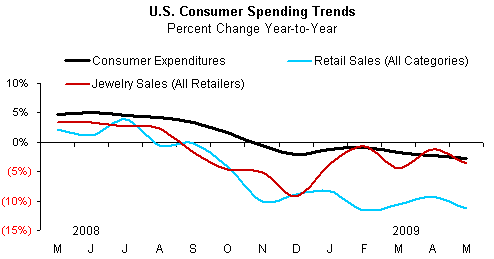
Source: US Dept of Commerce
Our Forecast: U.S. Jewelry Sales Flat-to-Up in 2009, But Not By Much
We try to be realistic, but, frankly, we are an optimist at heart. In the U.S., there are signs that indicate the recession is abating.
Earlier this year, our preliminary forecast had predicted that total U.S. jewelry sales in 2009 would be between about $59 billion and $60 billion, a decline of about 9 percent to 10 percent from 2008.
However, based on April and May jewelry sales figures, consumer jewelry expenditures could be flat-to-up slightly in 2009 – near $66 billion versus $65.8 billion last year. We are assuming that there will be no major “system shocks.”
For specialty jewelers, the 2009 sales decline could be 4-7 percent from 2008, yielding annual sales of about $27 billion. In 2008, specialty jewelers’ sales were $28.3 billion, down 6 percent from 2007’s $30.1 billion. Earlier this year, we had been predicting that specialty jewelers’ sales would be near $26 billion.
We’ve had several requests for our forecast for the all-important fourth calendar quarter. In our opinion, jewelry sales will be up from last year, if for no other reason than comparisons are so very easy. For specialty jewelers, sales in November and December 2008 were down roughly 21 percent. We believe that specialty jewelers’ sales in November and December 2009 could be up by at least 10 percent, and perhaps more. This suggests that 2009 holiday sales would be in the $8 billion range, well above last year’s $7.2 billion, but still below 2007’s $9.1 billion. The good news is this: late this year, we should start reporting sales comparisons using black ink, instead of the dreaded red ink that indicates a sales decline.
If our forecast of $27 billion for specialty jewelers in 2009 proves reasonably correct, and 2009 is, in fact, the bottom, specialty jewelers will have experienced an annual sales decline of only 13-14 percent or so from peak-to-valley in the current recession. This is a far cry from the 70 percent peak-to-valley decline experienced in the Great Depression.